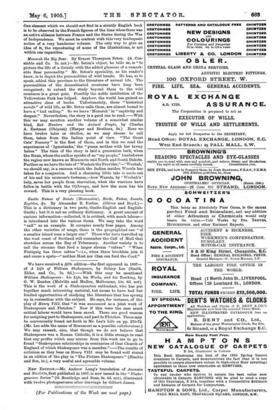Monarch the Big Bear. By Ernest Thompson Seton. (A. Con-
stable and Co. 5s. net.)—Mr. Seton's object, he tells us, is " to picture the life of a Grizzly with the added glamour of a remark- able Bear personality." Mr. Seton's speciality, as his reader's know, is to depict the personalities of wild beasts. He has, so to speak, added this province to the literature of animal life. The personalities of the domesticated creatures have long been recognised; to extend the study beyond them to the wild creatures is a great gain. Possibly the noble institution of the Yellowstone Park has helped. Anyhow, the world has gained an attractive class of books. Unfortunately, these " historical novels " of wild life, as Mr. Seton calls them, are almost bound to have a "bad ending." So we leave `Monarch' in "captivity and despair." Nevertheless, the story is a good one to read.—With this we may mention another volume of a somewhat similar kind, Red Hunters and the Animal People, by Charles A. Eastman (Ohiyesa) (Harper and Brothers, 5s.) Here we have twelve tales or studies, as we may choose to call them, taken from the Indian point of view. "The Great Cats' Nursery " is the first of them, and in this wo read the experiences of Igmutanka,' the " puma mother with her tawny babes." The time of the story is laid a generation back, when the Sioux, whom the author speaks of as "my people," hunted over the region now known as Minnesota and North and South Dakota. Further on we have the tale of " Wechah the Provider,"—` Wechab,' we should say, is a raccoon which the Indian maiden Wasula has taken for a companion. And a charming little tale is made out of his and his mistress's fortunes,—how Wasula, by Wechah's ' help, saves her people from starvation, when the warriors have fallen in battle with the Ojibways, and how the coon has his reward. This is a very pleasing book.










































 Previous page
Previous page